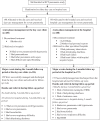Observational follow-up study following two cohorts of children with severe pneumonia after discharge from day care clinic/hospital in Dhaka, Bangladesh
- PMID: 22842561
- PMCID: PMC4400608
- DOI: 10.1136/bmjopen-2012-000961
Observational follow-up study following two cohorts of children with severe pneumonia after discharge from day care clinic/hospital in Dhaka, Bangladesh
Abstract
Objectives: To compare the features of relapse, morbidity, mortality and re-hospitalisation following successful discharge after severe pneumonia in children between a day care group and a hospital group and to explore the predictors of failures during 3 months of follow-up.
Design: An observational study following two cohorts of children with severe pneumonia for 3 months after discharge from hospital/clinic.
Setting: Day care was provided at the Radda Clinic and hospital care at a hospital in Dhaka, Bangladesh.
Participants: Children aged 2-59 months with severe pneumonia attending the clinic/hospital who survived to discharge.
Intervention: No intervention was done except providing some medications for minor illnesses, if indicated.
Primary outcome measures: The primary outcome measures were the proportion of successes and failures of day care at follow-up visits as determined by estimating the OR with 95% CI in comparison to hospital care.
Results: The authors enrolled 360 children with a mean (SD) age of 8 (7) months, 81% were infants and 61% were men. The follow-up compliance dropped from 95% at first to 85% at sixth visit. The common morbidities during the follow-up period included cough (28%), fever (17%), diarrhoea (9%) and rapid breathing (7%). During the follow-up period, significantly more day care children (n=22 (OR 12.2 (95% CI 8.2-17.8))) required re-hospitalisation after completion of initial day care compared with initial hospital care group (n=11 (OR 6.1 (95% CI 3.4-10.6))). The predictors for failure were associated with tachycardia, tachypnoea and hypoxaemia on admission and prolonged duration of stay.
Conclusions: There are considerable morbidities in children discharged following treatment of severe pneumonia like cough, fever, rapid breathing and diarrhoea during 3-month period. The findings indicate the importance of follow-up for early detection of medical problems and their management to reduce the risk of death. Establishment of an effective community follow-up would be ideal to address the problem of 'non-compliance with follow-up'.
Trial registration: The original randomised control trial comparing day care with hospital care was registered at http://www.clinicaltrials.gov (identifier NCT00455468).
Conflict of interest statement
Figures
References
-
- Black RE, Cousens S, Johnson HL, et al. Global, regional, and national causes of child mortality in 2008: a systematic analysis. Lancet 2010;375:1969–87. - PubMed
-
- Ashraf H, Chisti MJ, Alam NH. Treatment of childhood pneumonia in developing countries. In: Health Management, eds. Rijeka, Croatia: Sciyo, Krzysztof Smigorski ISBN 978-953-307-120-6 2010:59–88.
-
- Mulholland K. Magnitude of the problem of childhood pneumonia. Lancet 1999;354:590–2. - PubMed
Associated data
LinkOut - more resources
Full Text Sources
Medical

